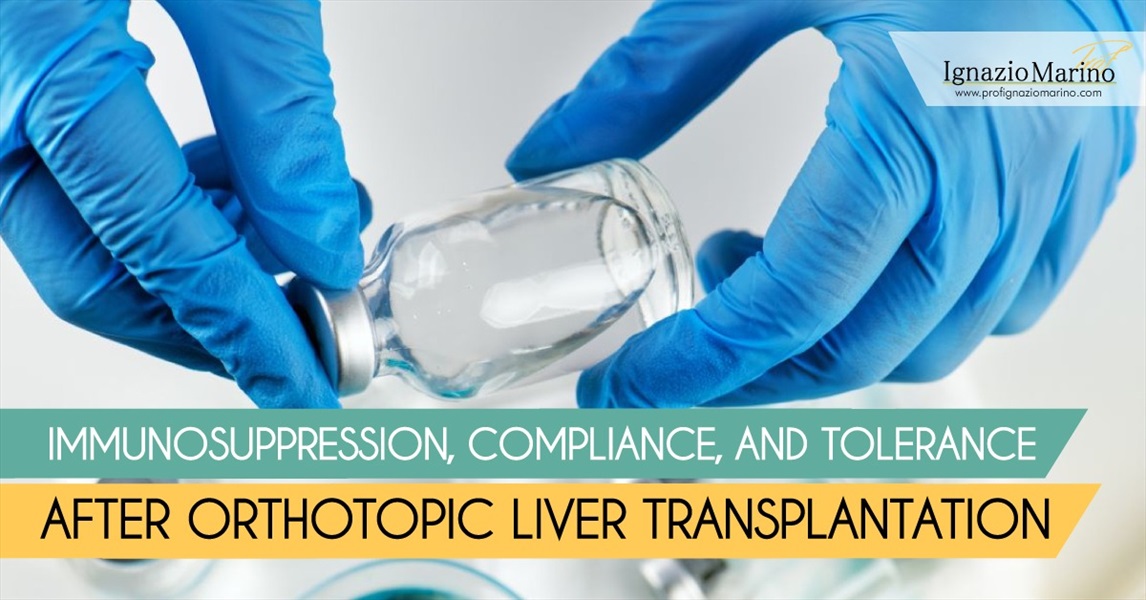Immunosuppression, Compliance, and Tolerance After Orthotopic Liver Transplantation: State of the Art
Noemi Zorzetti, Augusto Lauro, Simone Khouzam, Ignazio Roberto Marino
Orthotopic liver transplantation is the treatment of choice for several otherwise irreversible forms of acute and chronic liver diseases. Early implemented immunosuppressant regimens have had disappointing results with high rejection rates. However, new drugs have reduced the daily immunosuppression requirements, thereby improving graft and patient survival as well as kidney function. Liver rejection is a T-cell-driven immune response and is the active target of immunosuppressive agents. Immunosuppressants can be divided into pharmacological or biological drugs: the gold standard is the calcineurin inhibitors, steroids, mycophenolate mofetil, and mechanistic target of rapamycin inhibitors. Compliance with these agents is essential, although they can increase the risk of infections and neoplastic diseases. In some patients, graft tolerance can be achieved. Graft tolerance is defined as the absence of acute and chronic rejection in a graft, with normal function and histology in an immunosuppression-free, fully immunocompetent host, usually as the final result of a successful attempt at immunosuppression withdrawal. The occurrence of immunosuppressive-related complications has led to new protocols aimed at protecting renal function and preventing de novo cancer and dysmetabolic syndrome. The backbone of immunosuppression remains calcineurin inhibitors in association with other drugs, mainly over the short-term period. To avoid rejection and the side effects on renal dysfunction, de novo cancer, and cardiovascular syndrome, optimal long-term immunosuppressive therapy should be tailored in liver transplant recipients.
Introduction
Since the first human liver transplantation, performed in 1963 by T. E. Starzl in Denver, Colorado,1 orthotopic liver transplant (OLT) has been considered an experimental procedure up to the 1980s. Today, it is regarded as the treatment of choice for a number of otherwise irreversible forms of acute and chronic liver diseases.2
Following the success shown with regimens for kidney transplantation, early OLT immunosuppressant cocktails were based on azathioprine, corticosteroids, and antithymocyte globulins (ATGs). The results with these were disappointing with high rejection rates.3 However, with the introduction of cyclosporine, a new immunosuppressant in the early 1980s, rapid and significant improvements in survival were shown.4
Eventually, with the discovery of tacrolimus in the 1990s, outcomes of liver transplant recipients dramatically changed, with increased long-term graft and patient survival rates.5,6
Moreover, several later introduced new drugs (such as mycophenolate mofetil [MMF] or everolimus) (Figure 1) reduced the daily requirement of immunosuppression drugs among liver transplant recipients, improving their kidney function.
Immunosuppressive Therapy After Orthotopic Liver Transplant: State of the Art
Apart from hyperacute rejection, T-cell activation acts as the starter of the rejection cascade, with the key to controlling the rejection represented by immunosuppressive drugs. As stated earlier, the first regimens were characterized by high rejection rates, lower graft survival, and lower patient survival. Presently, there are different classes of immunosuppressive drugs that target the mechanisms of action focused on T-cell activation. Immunosuppressive agents can be divided into pharmacological or biological types (Table 1 and Table 2).
The corticosteroids are the first class of hormones and have lymphocytolytic effects.7 They interact with the immune system at various levels, reducing the number and size of lymphoid cells and inhibiting the production of inflammatory mediators such as platelet-activating factor, leukotrienes, and prostaglandins. Moreover, they inhibit monocyte and neutrophil chemotaxis and produce lympho- and neutropenia, not through direct cytotoxicity but by altering the diffusion of these cell populations. Corticosteroids are common components of combined immunosuppressant regimens and are also administered as intravenous boluses to treat acute rejection events. Glucocorticoids, particularly when used for long periods, have several side effects: glucose intolerance, hypertension, osteoporosis, muscle mass reduction, weight gain with central obesity, moon facies, striae rubrae, psychosis, cataract, glaucoma, and even iatrogenic Cushing syndrome.8,9
Cyclosporine, introduced in the 1980s,4 reduced the rates of rejection from 15% (reported by various groups) to 2% to 5%,10 validating calcineurin inhibitors (CNIs) as the backbone of immunosuppression. Tacrolimus (FK506), first used in clinical practice in the 1990s,11-13 and cyclosporine are CNIs, a serine-threonine phosphatase involved in the activation of various transcription factors. With activated T lymphocytes, the inhibition of calcineurin blocks the transcription of various cytokines, including interleukin 2, which plays a fundamental role in activating the immune response. Tacrolimus is more potent than cyclosporine in suppressing the immune response. The selected administered dose is based on drug levels in the blood, which need to be monitored at regular intervals. Both drugs are metabolized in the liver by the P450 IIIA cytochrome system, allowing reactions with other drugs to increase (erythromycin, fluconazole, verapamil, cimetidine) or reduce (phenobarbital, phenytoin, carbamazepine) cyclosporine or tacrolimus levels in the blood.
[...] Read full article
1. Starzl TE, Marchioro TL, Vonkaulla KN, Hermann G, Brittain RS, Waddell WR. Homotransplantation of the liver in humans. Surg Gynecol Obstet. 1963;117:659-676.
2. Rossi M, Mennini G, Lai Q, et al. Liver transplantation. J Ultrasound. 2007;10(1):28-45. doi:10.1016/j.jus.2007.02.006
3. Rolles K, Williams R, Neuberger J, Calne R. The Cambridge and King’s College Hospital experience of liver transplantation, 1968-1983. Hepatology. 1984;4(1 Suppl):50S-55S. doi:10.1002/hep.1840040715
4. Calne RY, Rolles K, White DJ, et al. Cyclosporin A initially as the only immunosuppressant in 34 recipients of cadaveric organs: 32 kidneys, 2 pancreases, and 2 livers. Lancet. 1979;2(8151):1033-1036. doi:10.1016/s0140-6736(79)92440-1
5. Jain A, Reyes J, Kashyap R, et al. Long-term survival after liver transplantation in 4,000 consecutive patients at a single center. Ann Surg. 2000;232(4):490-500. doi:10.1097/00000658-200010000-00004
6. Busuttil RW, Farmer DG, Yersiz H, et al. Analysis of long-term outcomes of 3200 liver transplantations over two decades: a single-center experience. Ann Surg. 2005;241(6):905-916; discussion 916-908. doi:10.1097/01.sla.0000164077.77912.98
7. Starzl TE, Marchioro TL, Rowlands DT, Jr., et al. Immunosuppression after experimental and clinical homotransplantation of the liver. Ann Surg. 1964;160:411-439. doi:10.1097/00000658-196409000-00007
8. Stegall MD, Everson GT, Schroter G, et al. Prednisone withdrawal late after adult liver transplantation reduces diabetes,hypertension, and hypercholesterolemia without causing graftloss. Hepatology. 1997;25(1):173-177. doi:10.1002/hep.510250132
9. Reding R. Steroid withdrawal in liver transplantation: benefits, risks, and unanswered questions. Transplantation. 2000;70(3):405-410. doi:10.1097/00007890-200008150-00001
10. Starzl TE, Iwatsuki S, Shaw BW Jr, Gordon RD, Esquivel C. Liver transplantation in the ciclosporin era. Prog Allergy. 1986;38:366-
394. doi: 10.1159/000318481
11. Starzl TE. First International Workshop on FK-506. A potential breakthrough in immunosuppression. Proceedings. Transplant
Proc. 1987;19(5 Suppl 6):1-104.
12. Randomised trial comparing tacrolimus (FK506) and cyclosporin in prevention of liver allograft rejection. European FK506 Multicentre Liver Study Group. Lancet. 1994;344(8920):423-428.
13. U.S. Multicenter FK506 Liver Study Group. A comparison of tacrolimus (FK 506) and cyclosporine for immunosuppression in liver transplantation. N Engl J Med. 1994;331(17):1110-1115. doi:10.1056/NEJM199410273311702
 06.60301809
06.60301809






